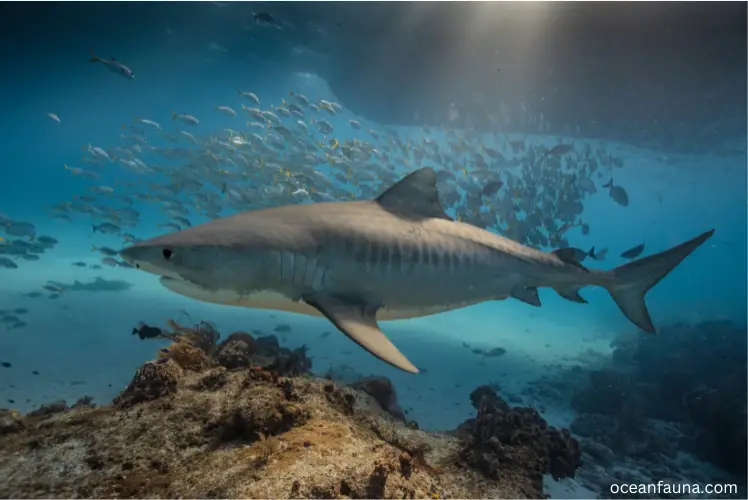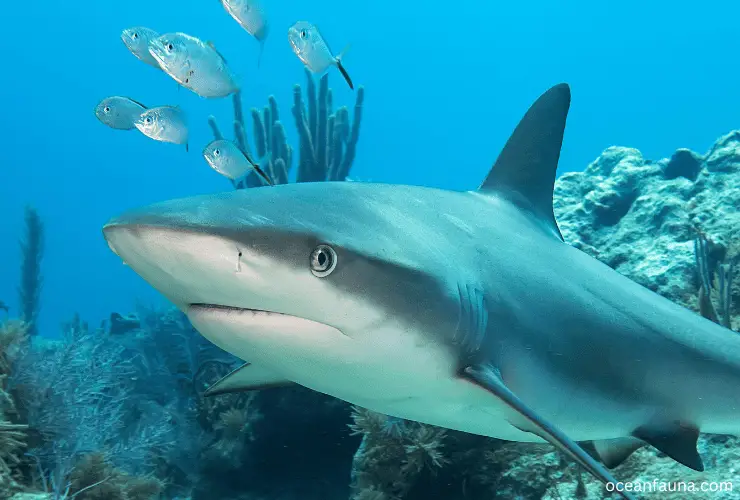If you plan on diving in Croatia’s waters, you should know that Croatia is situated on the border of the Adriatic Sea. Now you may ask, are there sharks in Croatia? Well, the answer is yes.
Croatia is the habitat of around 47 shark species, including bull, tiger, and great white sharks. And in this article, I will discuss Croatia’s most common shark species and some safety caution for diving. So read on.
Which Sharks Are There in Croatia? 9 Common Adriatic Shark Species
As I mentioned above, Croatia is a country located along the Adriatic Sea, the body of water separating the Balkan Peninsula from the Italian Peninsula. The Adriatic Sea is known for its rich biodiversity, and its waters are home to several species of sharks. Let’s take a closer look at the Adriatic sharks found in Croatia.
Blue Shark
The blue shark (Prionace glauca) is a slender, long-distance swimmer often found in open waters. It can grow up to 3.8 meters in length and weigh up to 206 kg. Blue sharks are one of the most common sharks in the Adriatic and are often found near the Peljesac Peninsula and along the country’s eastern coast. They prefer warm waters in the summer but migrate to colder ones in the winter.
Great White Shark
The great white shark (Carcharodon carcharias) is a large, predatory fish best known for its fearsome reputation. However, great white sharks are rare in the Adriatic and not commonly sighted in Croatia. They are mostly found in the Atlantic Ocean and the Mediterranean Sea, where temperatures are more suitable.
Bull Shark
The bull shark (Carcharhinus leucas) is a medium-sized species commonly found in coastal waters. They can grow up to 3.5 meters in length and weigh up to 316 kg. While bull sharks are known for their ability to swim in freshwater, they are still primarily saltwater sharks. Bull sharks have been recorded near Rovinj and Vodice in the Adriatic but are relatively rare.
Tiger Shark

The tiger shark (Galeocerdo cuvier) is a large, fierce predator known for its distinctive stripes and aggressive behaviour. They can grow up to 5.5 meters in length and weigh over 900 kg. However, tiger sharks are not commonly found in the Adriatic and are mostly confined to warmer waters further south.
Spiny Dogfish
The spiny dogfish (Squalus acanthias) is a small shark commonly found in the Adriatic. They usually grow to 1.2 meters and weigh up to 10 kg. These sharks are known for their sharp spines, which can cause injury if not handled carefully. Spiny dogfish are most commonly found along the coast of Istria.
Common Thresher
The common thresher shark (Alopias vulpinus) is a large species usually found in open water. They can grow up to 6 meters in length, and their elongated tail is used to stun prey. Common threshers are occasionally sighted in the Adriatic near Opatija or Split, but they are usually not common.
Shortfin Mako Shark
The shortfin mako shark (Isurus oxyrinchus) is a highly migratory species known for its incredible speed and agility. They can grow up to 4 meters in length and weigh up to 570 kg. Shortfin mako sharks are not commonly found in the Adriatic and are usually seen in more temperate waters.
Basking Shark
The basking shark (Cetorhinus maximus) is a filter-feeding species that feeds on plankton and small fish. They can grow up to 12 meters in length, making them one of the largest sharks in the world. Basking sharks are occasionally sighted in the Adriatic, primarily along the western coast.
Angel Shark
The angel shark (Squatina squatina) is a flat-bodied species that resembles a ray more than a traditional shark. They can grow up to 2.5 meters in length and weigh up to 90 kg. Angel sharks are occasionally seen in the Adriatic near Pula and Rovinj but are not a common sight.
Smooth-hound Shark
The smooth-hound shark (Mustelus mustelus) is a bottom-dwelling species that feed on crustaceans and molluscs. They usually grow to 1.2 meters in length and weigh up to 15 kg. Smooth-hound sharks are relatively common in the Adriatic, particularly along the southern coast near Dubrovnik. In the list of Dubrovnik shark attacks, you may find this shark.
Do Sharks Attack in Croatia?
Shark attacks in Croatia are rare, but they can occur. The Adriatic Sea shark attacks have been monitored since 1868, making it one of the world’s longest-standing records of shark attacks. The United States Shark Research Institute from Princeton, New Jersey, is now responsible for maintaining these records.
According to the available data, there have been only 21 documented cases of shark attacks in Croatia in the last 135 years, with only 11 of these being fatal. This indicates that the frequency of shark attacks in Croatia is very low, especially compared to other regions. For instance, the United States recorded a staggering 47 unprovoked shark bites in 2021 alone.
Despite the low numbers, some factors may increase the incidence of shark attacks in Croatia. For example, the Adriatic Sea is relatively shallow compared to other parts of the world, and its waters can become quite warm in the summer months, which may increase the activity of some shark species.
Additionally, the tourism industry in Croatia has been booming in recent years, with many visitors drawn to its pristine beaches and crystal-clear waters. This increase in human activity, coupled with the presence of baited water sports equipment and the feeding of marine life, may attract sharks closer to the shore.
Most shark species are not dangerous to humans, and fatal attacks are extremely rare. In fact, sharks play a critical role in maintaining healthy marine ecosystems and are vital to the balance of our oceans. That being said, beachgoers need to take precautions, such as avoiding swimming at dawn or dusk when sharks are most active, staying in groups, and refraining from wearing shiny jewellery or brightly coloured clothing.
Is it Safe from Sharks for Diving at the Adriatic Sea in Croatia?
The Adriatic Sea in Croatia is known for its stunning clear blue waters, and it is a popular destination for beach lovers and water enthusiasts. The good news is that the risk of shark attacks in this region is extremely low. In fact, only a handful of reported shark attacks in the Adriatic Sea have occurred in the past few decades.
Croatia’s coastline is situated on the eastern part of the Adriatic Sea, and the waters in this region are known to be generally safe for swimming and diving. The Adriatic Sea is home to various marine species, including small sharks such as the catshark and the dogfish. These sharks are not known to pose a danger to humans.
While shark attacks are a cause for concern in many parts of the world, they are an extremely rare occurrence in the Adriatic Sea. The risk of being attacked by a shark in the Adriatic Sea is significantly lower than being struck by lightning or being involved in a car accident.
However, it is always important to be aware of potential water hazards and take necessary precautions. Swimmers and divers should always remain cautious and vigilant and always exercise caution when swimming or diving in unfamiliar waters. Stay close to shore, avoid swimming during dusk or dawn when sharks are known to be most active, and avoid areas where fishing is taking place.
Diving With Adriatic Shark in Croatia: Best Time to Come
Diving in Croatia is an exhilarating experience that tourists from all over the world popularly enjoy. With such a long stretch of pristine coastline and stunning clear waters, diving has become a staple of this Mediterranean country.
One particular diving experience that draws attention is the opportunity to dive with Adriatic Sharks. But for those planning a visit to Croatia and specifically to dive with these magnificent creatures, the question arises, when is the best time to visit?
The best time to enjoy diving in Croatia, in general, is during the summer months of June to September. During this period, the weather is warm above and below the water, making it the perfect opportunity to dive with the Adriatic Sharks. This time of year is also considered the high tourist season for Croatia, which means there are plenty of tourists and avid divers to be found.
Diving with the Adriatic Sharks in Croatia is a unique and thrilling experience, as these sharks are found in large numbers in the Adriatic Sea. The sharks are generally docile and non-aggressive, which makes them relatively safe for divers to observe and interact with.
The sharks can grow up to lengths of two meters and are known for their distinctive grey colouration. Despite their size, these sharks feed mostly on small fish and are not considered a threat to humans.
During the summer months of June to September, there is a higher chance of spotting the sharks, as they are most active during this time. The warmer water temperatures during this period also facilitate plankton’s growth, attracting more fish and invertebrates, thereby drawing the sharks to specific locations.
Which Safety Cautions Must Be Followed for Diving in Croatia?
When diving in Croatia, it is extremely important to follow the safety precautions put in place by experienced and knowledgeable dive masters. It is also essential to adhere to any applicable local laws and regulations regarding marine life.
It is recommended that divers use appropriate gear and make sure their equipment is well-maintained. Divers must also consider the changing sea conditions and weather when planning their dives.
Also, remember that visibility can be poor at times due to the presence of plankton and other debris in the water. Finally, divers should keep a safe distance from any marine life they encounter while underwater. This will ensure both the safety of the diver and the preservation of Croatia’s unique marine ecology.
By following these safety measures, divers can ensure they have an enjoyable and safe experience while diving in Croatia. This will also help to protect the environment and preserve its delicate balance for future generations.
FAQs
Are there great white sharks in the Adriatic Sea?
Yes, there have been sightings of great white sharks in the Adriatic Sea, although they are rare. The Adriatic Sea is a body of water located between the Italian and Balkan peninsulas and is well-known for its clear waters and diverse marine life. While great white sharks are not common in this area, a few reported sightings have occurred over the years.
However, that great white sharks do not significantly threaten humans in the Adriatic Sea. In fact, there have only been a handful of reported shark attacks in this region, and none of them have been attributed to great white sharks. Instead, most attacks have been attributed to other species of sharks, such as blue and smooth-hound sharks.
Are sharks common in Croatia?
Yes, there are a number of different shark species that can be found in Croatia’s waters. The most common species of sharks in the Adriatic Sea include blue sharks, smooth-hound sharks, and shortfin mako sharks.
Conclusion
Hopefully, you have a clear knowledge of the types of shark species that can be found in the Adriatic Sea, as well as the safety measures that should be employed when diving in Croatia. Taking these precautions and observing local regulations and laws can ensure a safe and enjoyable dive experience while exploring Croatia’s diverse marine life.

